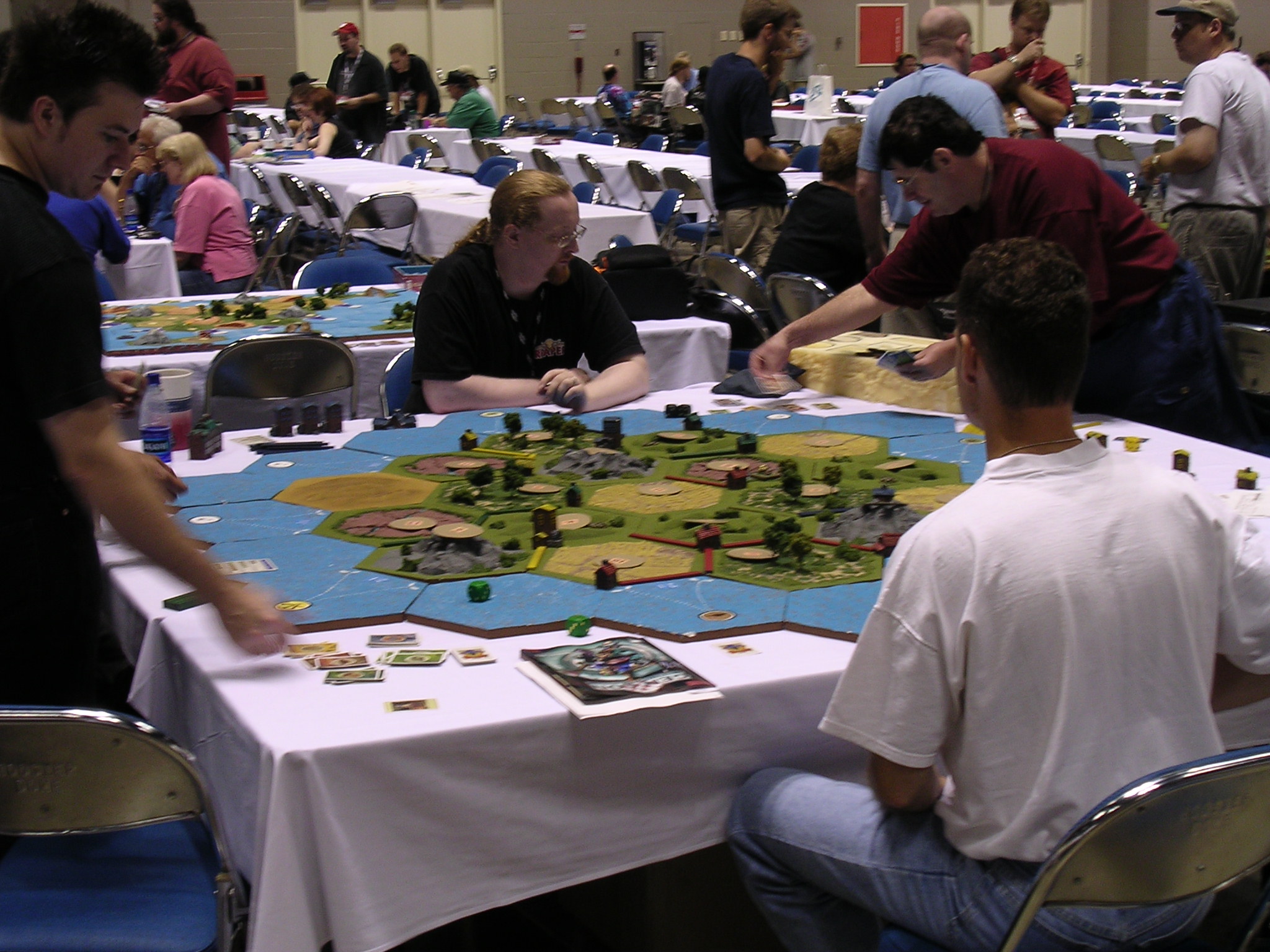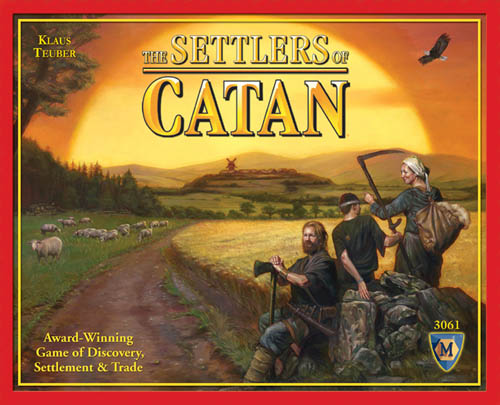Settlers of Catan is one of those neo-classic board games
that are a requirement for niche board game aficionados to own to maintain
their tabletop cred. It has won six
awards and is a staple of hobby shops.
And it is most certainly worthy of such popularity.
In Settlers of Catan (or just "Settlers", or just
"Catan") players compete to build on an island, constructing roads,
settlements, cities, armies, and more in an effort to wrest control of the
island and its precious resources.
To win, a player must have ten victory points, and gains
victory points for building settlements and cities, having the longest road or
largest army, or developing special buildings like a Palace or a Library.
The board is set up with randomly placed hex tiles, forming
a honeycomb island. Each hex can
generate one of five resources (cards designated as sheep, logs, wheat, bricks,
or rocks), except the desert hex, which produces nothing.
There are harbors that allow players to trade resources with
the bank at 3:1, or sometimes 2:1 for specific resources; and if a player does
not have a harbor in their grasp, they can still trade with the bank at 4:1.
However, trading with the bank should only be a last resort,
and trading with other players is the bigger key to success. Often, a player will have a monopoly on a
resource, or a resource will be particularly rare, so trading is a necessity to
get what you need. This is the main
mechanic of the game, which has players trading to help each other out even as
they compete for dominance.
 |
| "Let us work together so I can win." |
Once a player has the proper resources, they can trade them
in to the bank to build roads, settlements, cities, or purchase Development
Cards.
Development Cards can reveal knights to build up an army, special
buildings worth one victory point, or give a special ability, such as the
Monopoly card which allows a player to declare a resource type and force all
other players to give all of that resource they have to the player.
On its surface, Settlers looks a tad complex and
intimidating, but it is much simpler than it first appears. There are few specific rules that are not
immediately apparent, such as settlements (which can only be built on corners)
must be built at least two corners away from all other settlements.
However, these rules are just getting into the nitty-gritty,
and having a veteran Settlers player is all that is necessary to remind others
of such rules.
The instruction manual is composed of 3/4 glossary for easy
access to specific rules, so even with all first-time players, it's not
particularly difficult to learn. A
summary of how to play is only a single page (with a sample picture).
Each game is unique, because the harbors, resources, and
odds of resource production change every game with a random setup. Each player can have a different strategy or
make mid-course corrections.
For instance, I just played a game where rocks were
extremely rare, meaning that cities and Development Cards would be difficult to
get, so I and another player set about vying for making the Longest Road. I eventually found that it was impossible for
me to maintain the Longest Road ,
so I abandoned ship and switched to a settlement-building approach.
There is a fairly good split between luck and skill, for
resource production is dictated by dice, but most other actions are skill and
strategy.
 |
| There is also a giant version. For the near-sighted, I imagine. |
The final bit of business of Catan is the Robber, which is
helpful and terrible at the same time.
Rolling a seven or playing a Knight Card triggers the Robber, allowing a
player to move the Robber token to any resource hex, blocking production. All players with eight or more Resource Cards
must lose half of them, and then the player who triggered the Robber can steal
a Resource Card from a player who has a settlement or city next to the now-blocked
resource hex.
The Robber adds a dastardly element to the game, where
players have to be paranoid about having too many cards, and will often spend
resources to do something they don't really want, such as building a road when
they're trying to save up for a settlement.
Triggering the Robber by a Knight Card is at least
intentional, but rolling a seven is the luck of the dice. Sometimes, a player with eight or more cards
will roll a seven himself, and be forced to lose half of his own cards.
But all in all, Settlers is an extremely well balanced
game, offering multiple routes to victory for most players. On occasion, players have been screwed from
the start or have little opportunity, but there is a balanced setup in the
instructions for first time players so this does not occur on a first game.
There are also a few expansions to Settlers, allowing for up
to six players and adding new mechanics, as well as various standalone spin-offs.
However, since I haven't played them, I will have to review those at
another time.
 |
| Although this version seems intriguing. |
It is unfortunate that board games, apart from the Milton
Bradley and Parker Brothers classics, have become a niche market. If it only came out in an earlier era, it
could have become as popular as Risk or Monopoly.
If you enjoy good, easy-to-learn board games, but are tired
of Clue and Sorry!, find a hobby shop and pick up Settlers of Catan. If you're a board game hobbyist, pick it up,
too; it provides enough complexity and strategy to fit in with the rest of the
games on your shelf.
You can also buy it from the Settlers of Catan website.

No comments:
Post a Comment